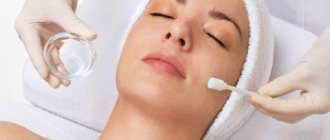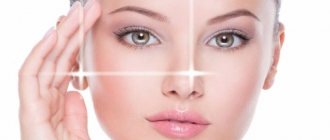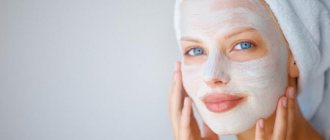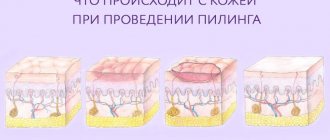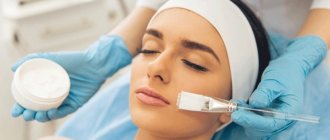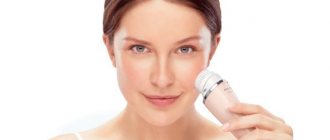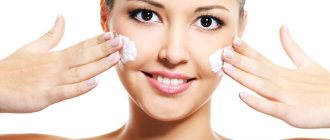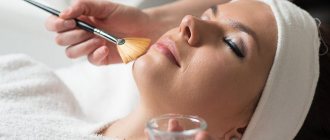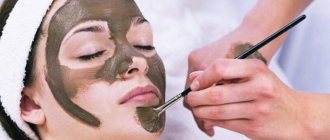The beauty of the fair sex knows no bounds. That is why girls and women use various compositions to carry out cosmetic procedures on their own, which would cost a lot of money in a salon. The leading position is occupied by peeling and its various variations, which help to achieve the desired result. This procedure is quite complicated and somewhat dangerous if all the rules and sequence are not followed. How to use peeling at home should be discussed thoroughly and in detail.
What is facial peeling and why is it needed?
Peeling is a procedure for removing the upper stratum corneum of the skin, after which the body launches restoration processes, and dead cells of our epidermis give way to new ones.
After exfoliating dead cells, the skin becomes soft, the complexion is evened out, pimples and blackheads disappear, and wrinkles are smoothed out. Peeling can lighten acne marks and scars, as well as even out skin texture. Creams, serums and various cosmetic procedures have a double effect: young cells respond better to active ingredients.
Peeling can be of several types:
- mechanical - using products with scrubbing particles;
- chemical - using acids or enzymes;
- hardware - using a special device.
Types of home peeling
A scrub is the most common product used to exfoliate the skin. It contains abrasive microparticles, with which it is easy to polish the dermis and get rid of dead cells. The best idea for home use would be a scrub that contains not only exfoliating, but also absorbent ingredients in the recipe - for example, charcoal. Such products not only perfectly renew, but also effectively cleanse the skin. If your face tends to develop unevenness and other imperfections, it makes sense to purchase a product with a well-known anti-stress ingredient - panthenol, as well as with the addition of zinc, which regulates sebum production. True, those with dry and sensitive skin should first test the composition they like, as some scrubs may be too hostile for them.
Gommage is optimal for highly sensitive and dry skin with a lot of problems. Gommage does not contain abrasives and treats the dermis as carefully as possible, so in the classical sense it can hardly be called a peeling preparation. Such products often contain fruit acids, as well as various components with care functions. The gommage is applied for 15-20 minutes, and then simply rolled off the surface of the face, removing the used layer of epidermis along with the product.
The film mask is optimal for dermis prone to blackheads. This is one of the “laziest” types of home peeling: after waiting a certain amount of time (usually no more than ten minutes), you only need to remove the mask with a sharp movement, and with it remove impurities and dead skin cells of the dermis.
Maxa Scrub also perfectly cleanses the face of dead skin cells and dirt. The main condition is to apply it away from the lips and eyes.
Acid-based creams and gels work to accelerate skin regeneration, but at the same time have a rather gentle effect. These products are optimal for eliminating wrinkles, unevenness, excess pigmentation and other imperfections, and reducing the number of acne. This type of peeling can be used quite often, sometimes daily, however, strict compliance with the manufacturer’s requirements is considered an important condition. The formulation of the most common products includes fruit and salicylic acids, as well as rich phytocomplexes.
pexels.com/Miriam Alonso
Types of chemical peels for the face
Chemical peels can be distinguished by the depth of their penetration into the skin:
1) Superficial
Gives the most delicate exfoliation that affects the top layer of skin. During the process, as a rule, there is no unpleasant burning sensation, and afterward the skin almost does not peel off. Therefore, superficial peeling is suitable for sensitive skin and those who are just beginning their acquaintance with such procedures.
If you are unhappy with fine wrinkles, dull complexion or pimples, contact him. It is better to do it in a course - for example, four superficial peeling procedures give the same effect as one medium peeling procedure, but without side effects.
Types of superficial peeling: soft AHA acids - mandelic, glycolic, tartaric, malic; trichloroacetic acid (TCA) – 1-15%, low concentration of salicylic acid; Enzyme peeling based on the papain enzyme.
Surface peeling procedure with ARAVIA Professional products
2) Middle
Pigmentation caused by the sun, shallow scars and acne marks are indications for medium peeling, which affects not only the epidermis, but also the papillary dermis - the second layer of skin. This type of peeling requires a longer recovery period - about 14 days, but gives a more visible result in one procedure.
Types of medium peeling: 25-30% solution of trichloroacetic acid (TCA), 20% salicylic acid.
3) Deep
Penetrating deep into the skin and affecting all layers of the epidermis, deep peeling can solve serious problems - for example, smooth out deep acne scars, old scars or even out loose skin texture.
After the procedure, the skin is very flaky, itchy or even crusty - the recovery period lasts about 20 days. Deep peeling should be carried out for special indications, when the complex of superficial and middle peels can no longer cope.
Types of deep peeling: 35-50% TCA, phenol.
Preparing and performing a home peeling procedure
The only important requirement for the effectiveness of a home procedure for renewing the dermis is its thorough cleaning. Remove makeup and physical impurities using conventional products: micellar water or milk, then wash with soft foam, apply the peeling composition to a slightly damp face, lightly massage the skin, and then rinse off the composition.
Do not forget that peeling is not only a highly effective manipulation, but also a considerable stress for the dermis, so you should remember the safety rules. So, it is advisable to carry out peeling in the evening, so that your skin has the whole night to adapt to future environmental influences: frost, heat, dust, ultraviolet radiation. You should also not apply the peeling product to the skin around the lips and eyes. In general, the application should resemble a light massage, and the session should not last more than three minutes. Then the product should be rinsed off thoroughly.
After the procedure, the skin will tell you a special “thank you” if you give it a moisturizing or nourishing mask, apply serum and cream, and the next day provide intense protection from sun rays.
What is the difference between mono- and multi-acid peels?
Peeling can consist of either one type of acid - these are called mono-acid peels, or two or more - these are multi-acid peels. The combination of acids allows you to solve several problems at once and achieve more visible results.
You won’t be able to get a multi-acid peel by simply mixing several acids: some of them negatively affect each other and can seriously harm the skin.
That is why the selection of concentrations and working ingredients is best left to professionals. Together with dermatologists and chemist-technologists, the ARAVIA Professional brand has developed four “cocktails” of the MG Peel System, intended for both young problem skin and aging wrinkled skin. It is based on proprietary combinations of acids that provide maximum results and minimal discomfort - thanks to optimal concentration and a comfortable pH of 3.0.
FAQ
Potential clients of cosmetology clinics often have a number of questions. The most typical of them include:
- How to choose the right procedure based on the client’s age and skin type?
- Is it possible to clean and exfoliate at the same time?
- Is it possible to exfoliate after cleansing?
- Which procedure should I choose in terms of economy?
What to prefer depending on skin type
Age characteristics of the skin and its type are the main criteria that should be followed when choosing a facial cleansing procedure.
Table “Skin type and cosmetic procedures”
| Skin type | Professional facial cleansing | Peeling |
| Normal | Ultrasonic | Containing fruit acids, scrubbing is acceptable. |
| Dry | Ultrasound, Laser biorevitalization | Cream peeling, roller peeling, ultrasonic peeling or laser resurfacing are acceptable. |
| Fat | Manual procedure using a spoon or Uno loop | Containing hyaluronic acid, let's say Brossage or microdermabrasion. |
| Problematic | Vacuum or deep ultrasonic | Jessner peel, saline or retinoic. |
Is it possible to do peeling and cleansing at the same time?
Is it possible to do peeling and cleansing at the same time?
As a rule, it is not forbidden to do two of these procedures at the same time - they enhance the effect of each other and complement each other perfectly. But only a cosmetologist should decide on the advisability of such an integrated approach. Ideally, there should still be a certain interval between such interventions so as not to injure the skin needlessly.
Is it possible to exfoliate after cleansing?
Is it possible to do peeling after cleansing the skin of the face?
Yes, because these two procedures are considered complementary.
Thus, cleansing after peeling helps to more effectively, easily and quickly remove impurities from the pores.
Exfoliation after cleansing will allow you to maintain the achieved result for a long time, at the same time evening out your complexion and eliminating the first signs of skin aging.
Peeling in the salon or at home: pros and cons
So where should you peel: at home or in the salon? It seems to be cheaper at home, and folk remedies can be used. We explain why such a cosmetology initiative is dangerous and why it is better to trust a professional:
1) You can literally “burn” your skin
Peeling is an actual burn of the skin. The degree of this burn is regulated by a cosmetologist: he selects a solution for the skin type and strictly monitors the time of its application. Application technology is also important. Imagine how, due to the carelessness or ignorance of a novice amateur, such a serious procedure can affect the skin: it risks getting burned, and after the burn, scars or scars.
2) A cosmetologist will select an effective course
Can you determine your skin type? Maybe you think it's dry, but in fact it's dehydrated? A cosmetologist will be able to select a peeling for your skin type and its needs, create an optimal course, which may consist of peels of varying depths and strengths, and will monitor the processes of regeneration and restoration - select appropriate home care and give practical recommendations.
3) Folk remedies don’t work
“Creating” acid peeling at home is impossible. Yes, mild AHAs used in superficial peels are often obtained from fruits and berries. But strawberry puree won't actually do anything to your face.
Be careful with folk remedies. They can cause allergies Photo: user18526052 / Freepik
Frequency of procedure
Since peeling has a serious impact on the facial skin, it must be done with a certain frequency. Girls with dry skin are not recommended to use peeling frequently. Once every two weeks is enough. Carefully monitor the condition of your skin during the break, because sometimes you can deviate from the rules as necessary.
Normal facial skin will look charming and fresh with the frequency of peeling once a week. But oily skin can be cleansed twice a week. It is much more often necessary to use formulations if there are serious skin problems caused by impaired sebum secretion, which clogs pores and provokes the formation of acne.
Also, when talking about how often you can use peeling, you should not forget about its composition. Therefore, before purchasing, be sure to read the instructions for use, which often indicate not only the method, but also the frequency of use.
How to properly peel your face: briefly
1) Peeling is best done in autumn or winter: this way, sunburn and damage to irritated skin is minimal.
2) Deep peeling is a serious procedure that requires special indications in the form of pronounced scars or scars. It is worth resorting to it in exceptional cases, but it is better to start with superficial peels - they do not cause irritation, but at the same time improve the appearance.
3) Trust a professional - he will select the type of peeling, protect you from chemical burns, give recommendations on how to prolong the effect and select home care. If you are an advanced cosmetics user, peeling can be done at home. Read the manufacturer's recommendations carefully and follow the instructions.
Precautions when using peeling
It is necessary to use peeling correctly, observing all the features of using the composition you have chosen. But among all the nuances, several general recommendations can be identified, which include:
- The procedure cannot be carried out in case of exacerbation of acne; here it is possible to use only gels that provide gentle cleansing;
- if there is personal intolerance to the components of the drug;
- Peeling procedures should not be performed on highly sensitive facial skin;
- in the presence of any inflammatory processes;
- cleansing with a feature in the form of dilated vessels is prohibited;
- Peeling should not be used if there are unhealed cuts or ulcers.
Compliance with these precautions will help you avoid a number of problems with your skin and its condition in the future.
Step-by-step technology
- Wash your hands with soap.
- Remove makeup and cleanse your face with your usual product (tonic, foam, gel, etc.).
- Wash your face with water and dry your face with a towel.
- Apply Vaseline to the eye area, lips and eyebrows. This will help protect delicate areas from the effects of the drug.
- Read the recommendations for using the peeling product and strictly follow the application instructions.
- Using a brush or cotton swab, apply the composition first to the nose and chin, then to the forehead and cheeks. Make sure that the mixture is evenly distributed.
- Leave the product on the skin for the time indicated in the instructions. For the initial procedure, a minimum period of time is sufficient; depending on the frequency of use, you can increase the amount of time.
- Monitor your skin's reaction; if you feel any discomfort, remove the product immediately.
- After time has passed, rinse off the product with cool water or a special tonic that neutralizes the effects of acids.
- Treat your face with a product to restore pH balance.
- After the product is completely absorbed, apply a moisturizer.
Composition selection
You can prepare a homemade peeling product yourself from natural products or buy a ready-made composition.
Let's look at what components will help cleanse the skin for different skin types:
- Dry. Low-abrasive components (flour, coffee grounds, pine nuts, crushed wheat flakes) are suitable for mechanical exfoliation of keratinized particles. The most suitable compositions for the chemical procedure are fruit pulp or juice, fermented milk products, honey, and herbal decoctions that are applied to the face.
- Fat. More aggressive agents are used (salt, soda, ammonia, boric acid, cane sugar).
- Normal. Peeling for this type of epidermis is preventive in nature. Vegetable pulp, coffee grounds, crushed tea leaves, ground oatmeal and nuts are suitable for the procedures. In order not to provoke thinning of the skin of the face, you should not get carried away with abrasive components.
- Fading. Aging dermis should not be subjected to aggressive cleansing methods. Good results are achieved by gentle peelings with fermented milk products (kefir, yogurt, sour cream), with oatmeal and milk, poppy seeds and sea salt with the addition of softening ingredients (vegetable oil, egg yolk, cream or honey).
When choosing a peeling composition, you need to take into account your skin type, age, the possibility of a recovery period, as well as the expected result. Better results can be achieved by using additional accessories (glove, brush or washcloth) during the procedure.
